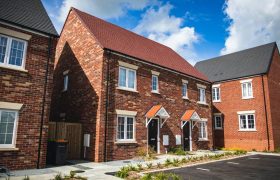As the pressure around climate change increases and the UK government ramps up activities to drive towards Net Zero by 2050 (2045 in Scotland), drastic changes are required to domestic heating — with electrification and an increased use of heat pumps at the forefront.
Domestic properties account for 19% of the carbon emissions and 30% of the energy usage in the UK*. Unsurprisingly, the decarbonisation of this critical mass remains high on the government agenda in the form of the Future Homes Standard and changes to the Part L Building Regulations.
The Challenges of Decarbonisation in the UK
A recent Environmental Audit Committee report described the challenge of decarbonising existing properties as “colossal” and was fairly damning of the policy and funding implemented so far. The challenge of the retrofit puts even more pressure on the drive for success in the new build sector.
Seen by many as a “low hanging fruit” when it comes to the decarbonisation of domestic dwellings, the pathway for the new build segment looks fairly well set, with policy in motion to remove fossil fuels from new build properties by 2025.
So, what does that pathway to zero fossil fuels in new build properties look like and what opportunities and challenges lie ahead?
What is Interim Part L of the Building Regulations?
Interim Part L is the first step towards the Future Homes Standard, the long-awaited update to Part L. Delayed due to Covid-19, it is set to arrive in December 2021 ahead of its implementation in June 2022.
Purposefully titled an “interim” policy, it’s designed to pave the way for low-carbon heating becoming the norm in new build homes by introducing steps to make properties ”low carbon ready”. It also tightens up the transitional arrangements to ensure the impact will be seen sooner rather than later.
In summary, the Interim Part L includes:
- A 31% reduction in carbon emission targets
- Maintenance of FEES to uphold fabric efficiency standards
- Minimum fabric and fixed building services standards including for:
- Gas Boilers – 92% ErP
- Heat Pumps – SCOP 3.0
- A maximum 55deg design temperature
- Transitional arrangements capped at 1 year and on a plot by plot basis
Proposals that were consulted on, but not included in the Interim Part L, included an affordability factor, removal of FEES and removal of local authorities’ ability to set higher targets.
Achieving Interim Part L
It’s anticipated that the Interim Part L targets can be achieved with the use of a high efficiency condensing gas boiler, combined with additional energy efficiency measures such as solar PV, waste water heat recovery (WWHR) or flue gas heat recovery (FGHR) whilst maintaining broadly the same space envelope as current designs.
Alternatively, installation of a heat pump will easily achieve the required targets. The use of domestic heat pumps on selected strategic sites will enable early introduction and trial of the technology prior to it becoming a mainstream solution.
What is the Future Homes Standard?
Despite delays to the release of the Interim Part L, the Government is holding fast on targets for the release of the Future Homes Standard. Technical consultation is due in 2023, with release in 2024 and implementation to follow in 2025.
The Future Homes Standard marks a new era for new build properties, with carbon emission targets expected to be 75-80% lower than the current rates. This will effectively bring an end to the use of fossil fuels in this sector.
The Future of Domestic Heat Pumps in the UK
It’s anticipated that the Future Homes Standard will drive the widespread uptake of heat pump technology in the new build sector. Whether that is air-source heat pumps in new build houses, heat pump water heaters combined with electric panels in apartments, or a low-carbon plant room with HIUs for densely populated flats, it’s clear the future for the new build is electric.
Here at Ideal Heating, we’re working on a range of low carbon heating solutions including our recently-launched heat pumps. Our heat pumps will help to ensure new build homes meet the Future Homes Standard when the legislation comes into effect.
Creating Heat Pump Success in the New Build Sector
It’s clear from speaking to new build developers that heat pumps make them slightly nervous; it’s a large change for the sector and some have even had previous negative experiences.
However, the heat pump market has been quietly growing in the background, with their popularity exploding in some European countries due to government legislation and funding. Things have moved on, the technology is more mainstream and we now know how to harness its benefits to provide a great experience for homeowners.
There are several benefits to the Ideal Heating Alfea heat pumps for new build properties. The air-to-water heat pump not only offers optimum comfort and low environmental impact, it has been purposefully designed to perfectly suit new build properties. Its compact and modular design allows for quick and efficient installation and - even better - it arrives pre-assembled for a truly effortless set-up.
How Can Heat Pump Manufacturers Support New Build Developers?
Absolutely critical to the success of heat pumps is the support the manufacturer can provide to the developer; a full wrap-around package of both pre and post-sales support is essential.
The success of a heat pump installation is largely dependent on the sizing and design process. A robust sizing tool combined with an experienced in-house design team will underpin the initial specification of the product. Manufacturer training will be key for installers, as well as ensuring experienced after-sales technical support is readily available.
Finally, support to the homeowner cannot be underestimated; ensuring knowledgeable help is on the end of the phone and providing clear user guides and support videos will help the customer understand their new heating system and encourage them to run it in the most efficient and optimal way.
Why Heat Pumps Will be Essential for Reaching Net Zero
The government is right when it says the new build sector is the best place to introduce highly efficient heat pump technology. The opportunity to build in heat pump and low-temperature heating system design from the start, combined with the excellent fabric standards and low heat demands of new build properties mean they are perfectly positioned to adopt these products and lead the drive towards achieving Net Zero.
Find out more about the Ideal Heating heat pump range and discover how we can help you get ready to take your first step towards the Future Homes Standard.
For more heat pump related news, expert tips and to stay up-to-date with the latest posts, why not bookmark our Ideal Heating blog?
*House of Commons, Environmental Audit Committee Energy Efficiency of Existing Homes Fourth Report of Session 2019–21.




